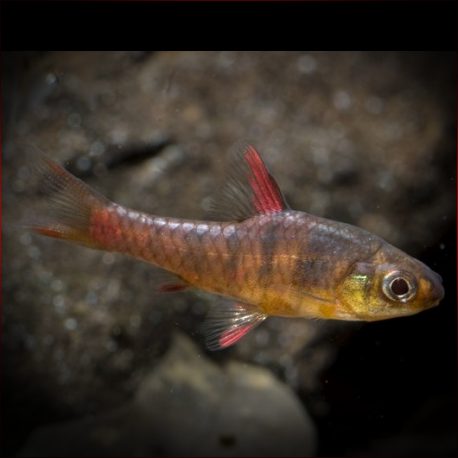More info
Datasheet
| Minimum Tank Size | 40 litres / 10.57 US gallons |
| Maximum Size | 4.0cm / 1.57inches |
| Temperature | 17°C / 62.60°F - 24°C / 75.20°F |
| Hardness | 1.01dgH / 18ppm - 5.04dgH / 90ppm |
| pH | 5.0-6.5 |
General Description
Barbus Jae, also known as B. Jae or Charcoal barb, is a delicate species sought after by enthusiasts, native to West African countries, specifically Cameroon, Equatorial Guinea, Gabon, the Republic of the Congo, and the Democratic Republic of the Congo. It belongs to the Cyprinidae family and can grow up to 4.0cm in size. The species exhibits various color forms that should not be mixed in aquariums to avoid crossbreeding.
Aquarium Setup
To provide an optimal environment for B. Jae, a well-planted tank with soft water and a biotope-style setup is recommended. The tank should have a soft, sandy substrate, driftwood roots, and branches creating plenty of shady spots. Including dried leaf litter like beech, oak, or Ketapang almond leaves is beneficial, as they offer cover, encourage microbe colonies for additional food sources, and enhance coloration. Dim lighting, African plants such as Anubias species, and floating vegetation to diffuse light are ideal. It is advised to avoid adding B. Jae to a newly established tank to prevent water chemistry fluctuations.
Behaviour
B. Jae has a shy and retiring nature, making it unsuitable for most community aquaria due to intimidation or food competition from larger or more boisterous tankmates. It is recommended to keep them with similarly-sized, peaceful fish species in a group of 8 or more to establish a pecking order. When kept singularly or in small groups without adequate space, they may become withdrawn, with subdominant individuals facing potential bullying.
Feeding and Diet
In their natural habitat, B. Jae likely feeds on insect larvae and small crustaceans. In aquariums, they accept dried foods but should primarily be fed small live and frozen foods like Daphnia and Artemia. A diet rich in live and frozen foods enhances coloration and promotes breeding behavior in these micropredators.
Reproduction & Dimorphism
Barb Jae is a seasonal spawner, with breeding activity occurring over two periods each year. It is an egg-scattering, continuous spawner displaying zero parental care. To increase fry yield, a controlled breeding setup is recommended with suitable water conditions and spawning sites. Males exhibit brighter colors during breeding, while females are duller and thicker-bodied. Successful breeding can lead to the appearance of fry after around 7-10 days, which require microscopic food initially.
Habitat and Distribution
In the wild, B. Jae inhabits slow-moving, shallow, shady rainforest streams and swamps characterized by soft, acidic, and cool water with stained brown coloration due to organic matter decomposition. Various populations across West African countries exhibit color and patterning variations, emphasizing the need for accurate labeling to preserve distinct bloodlines within different collection localities.

